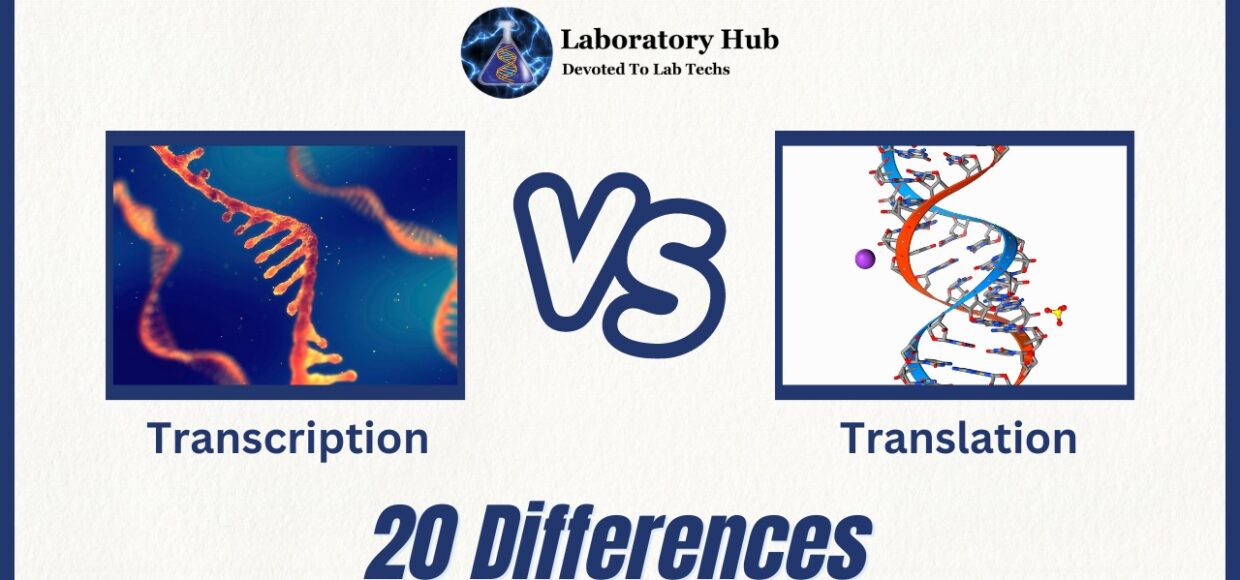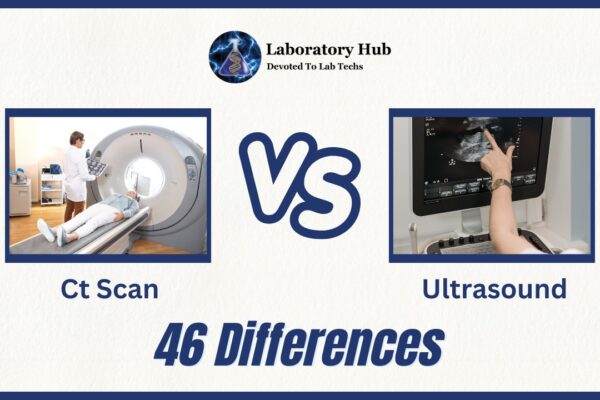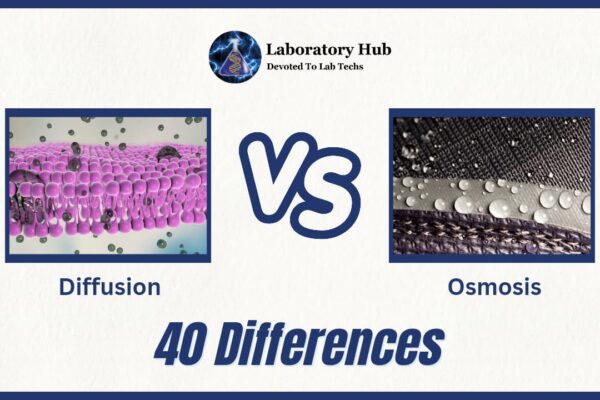Transcription vs Translation- 20 Differences
Introduction
Transcription and translation are crucial to genetic information expression in genetics and molecular biology. All living things, from bacteria to people, depend on these processes. Transcription and translation are linked but have different roles in genetic information transfer.
DNA to RNA to protein is the core postulate of molecular biology, and transcription is the initial step. The nucleus or cytoplasm of eukaryotic or prokaryotic organisms synthesizes an RNA molecule from a DNA template. RNA polymerase forms complementary RNA molecules from the DNA template. Messenger RNA (mRNA) transports genetic information from DNA to protein production.
Translation, the second phase of the core dogma, synthesizes proteins. All cells’ cytoplasms convert mRNA’s genetic information into amino acids, the building blocks of proteins. RNA-protein ribosomes perform this intricate process. The ribosomes match mRNA codons, a sequence of three nucleotides, with transfer RNA (tRNA) molecules containing specific amino acids. The amino acids create a polypeptide chain, which folds into a protein, through chemical processes.
READ ALSO: Are anti-sleeping pills safe for you?
Transcription and translation are essential processes in gene expression, but their methods, sites, and products differ. Transcription creates an RNA molecule that contains genetic information from DNA, while translation transforms the mRNA sequence into a polypeptide chain that makes a protein. Translation happens in the cytoplasm, while transcription occurs in the nucleus (eukaryotes) or cytoplasm (prokaryotes). RNA polymerase catalyzes transcription and ribosomes and transfers RNA molecules to translate.
Understanding transcription and translation is crucial to understanding the complex mechanisms that underpin genetic information expression. Transcription synthesizes mRNA from a DNA template, while translation converts it into a polypeptide chain to make proteins. These mechanisms shape all living beings.
S.No. | Category | Transcription | Translation |
1 | Definition | Transcription is the process of synthesizing an RNA molecule from a DNA template. | Translation is the process of synthesizing a protein using the information encoded in an mRNA molecule. |
2 | Location | Transcription occurs in the nucleus of eukaryotic cells and the cytoplasm of prokaryotic cells. | Translation occurs in the cytoplasm of both eukaryotic and prokaryotic cells. |
3 | Starting Molecule | Transcription starts with DNA as the template molecule. | Translation starts with an mRNA molecule as the template. |
4 | Enzyme | RNA polymerase is the enzyme involved in transcription. | Ribosomes, along with tRNA and various protein factors, are involved in translation. |
5 | Product | The product of transcription is an RNA molecule, such as mRNA, rRNA, or tRNA. | The product of translation is a protein. |
6 | Template Strand | Transcription uses one of the DNA strands as the template strand. | Translation does not involve a template strand. |
7 | Base Pairing | During transcription, RNA nucleotides pair with complementary DNA nucleotides. | During translation, codons on mRNA pair with anticodons on tRNA. |
8 | Initiation | Transcription initiation involves the binding of RNA polymerase to the promoter region on DNA. | Translation initiation involves the binding of the small ribosomal subunit to the mRNA start codon. |
9 | Elongation | During transcription elongation, RNA polymerase synthesizes the RNA molecule by adding complementary nucleotides. | During translation elongation, ribosomes move along the mRNA, synthesizing the growing polypeptide chain. |
10 | Termination | Transcription termination occurs when RNA polymerase reaches a specific termination sequence on DNA. | Translation termination occurs when a stop codon is reached on the mRNA, signaling the release of the newly synthesized protein. |
11 | RNA Processing | Transcription may involve RNA processing steps, such as capping, splicing, and polyadenylation in eukaryotes. | Translation does not involve RNA processing. |
12 | Energy Requirement | Transcription requires the input of ATP for the synthesis of RNA. | Translation requires the input of GTP and ATP for the formation of peptide bonds and energy for ribosome movement. |
13 | Regulation | Transcription is highly regulated through transcription factors, enhancers, and repressors. | Translation is also regulated through various mechanisms, such as initiation factors and regulatory proteins. |
14 | Variability | Multiple RNA molecules can be transcribed from the same DNA template at the same time. | Multiple ribosomes can simultaneously translate the same mRNA molecule, forming a polyribosome. |
15 | Error Correction | Transcription has a lower level of error correction mechanisms compared to translation. | Translation has more robust error correction mechanisms, such as proofreading by aminoacyl-tRNA synthetases and ribosome quality control. |
16 | Post-Process Modifications | Transcribed RNA molecules can undergo various post-transcriptional modifications, such as splicing, editing, and polyadenylation. | Translated proteins can undergo post-translational modifications, such as folding, cleavage, phosphorylation, and glycosylation. |
17 | Inhibition | Transcription can be inhibited by various factors, such as transcriptional repressors and DNA damage. | Translation can be inhibited by antibiotics, such as tetracycline and chloramphenicol, or regulatory factors affecting ribosome function. |
18 | Template Usage | The DNA template used in transcription can be used repeatedly for multiple rounds of transcription. | The mRNA template used in translation is typically used for a single round of translation. |
19 | End Product | The end product of transcription is an RNA molecule that may have functional roles as RNA or serve as a template for translation. | The end product of translation is a functional protein that carries out various cellular functions. |
20 | Overall Function | Transcription converts genetic information from DNA into RNA. | Translation converts genetic information from RNA into proteins. |
Frequently Asked Questions (FAQs)
Gene expression involves transcription and translation. Transcription synthesizes an RNA molecule from a DNA template, whereas translation converts mRNA’s genetic information into a protein sequence. Transcription copies DNA into RNA, whereas translation turns RNA into protein.
DNA in eukaryotic organisms is transcribed. Transcription occurs in the cytoplasm of prokaryotic organisms. Eukaryotic and prokaryotic cells translate in the cytoplasm. During transcription, mRNA is transferred from the nucleus to the cytoplasm, where ribosomes translate it.
Transcription requires RNA polymerase. It synthesizes a corresponding RNA molecule from the DNA template. Ribosomes drive translation. They link mRNA sequences with amino acid-carrying transfer RNA (tRNA) molecules. Ribosomes connect amino acids into a polypeptide chain, which folds into a functional protein.
The core dogma of molecular biology defines genetic information flow through transcription and translation. DNA to RNA to protein is the basic dogma. Transcription converts DNA into RNA, while translation turns RNA into protein. This sequential information flow controls all living things.
External influences affect transcription and translation. Transcription factors, which govern RNA polymerase binding to the DNA template, can influence transcription. Environmental circumstances and cellular signals can alter transcription. Post-transcriptional changes, RNA stability, and tRNA availability also control translation. These regulatory systems fine-tune gene expression to the organism and environment.







